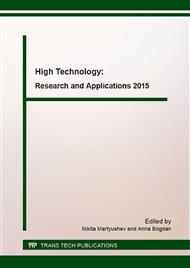[1]
D. A. Voyno, K.I. Machekhina, L.N. Shiyan, The forming of model colloid system, Adv. Mater. Res. (2014) 266-269.
DOI: 10.4028/www.scientific.net/amr.971-973.266
Google Scholar
[2]
L.V. Serikov, E.A. Tropina, L.N. Shiyan, F.H. Frimmel, G. Metreveli, M. Delay, Iron oxidation in different types of groundwater of Western Siberia, J. for Soils and Sedim. (2009) 103-110.
DOI: 10.1007/s11368-009-0069-x
Google Scholar
[3]
B. Gu, J. Schmltt, Z. Chen, L. Liang, J. McCarthy, Adsorption and desorption of natural organic matter in iron oxide: mechnisms and models, Environ. Sci. Technol. (1994) 38-46.
DOI: 10.1021/es00050a007
Google Scholar
[4]
M. Lehtola, I. Miettinen, M. Keinanen, T. Kekki, O. Laine, A. Hirvonen, T. Vartiainen, P. Martikainen, Microbiology, chemistry and biofilm development in a pilot drinking water distribution system with copper and plastic pipes, Water Research (2004).
DOI: 10.1016/j.watres.2004.06.024
Google Scholar
[5]
K.I. Machekhina, L.N. Shiyan, Process of ultra- and nanofiltration for cleaning solutions from iron colloid substances, Adv. Mater. Res. (2014) 342-346.
DOI: 10.4028/www.scientific.net/amr.1040.342
Google Scholar
[6]
P. Westerhoff, P. Chao, H. Mash, Reactivity of natural organic matter with aqueous chlorine and bromine, Water Research (2004) 1502-1513.
DOI: 10.1016/j.watres.2003.12.014
Google Scholar
[7]
E.M. Svetleishaya, T.E. Mitchenko, I.M. Astrelin, Removal of Natural Orginic Matter by Ultrafiltration, J. of Water Chem. and Technol. (2014) 47-56.
DOI: 10.3103/s1063455x14010044
Google Scholar
[8]
J. Ma, G.B. Li, Z.L. Chen, G.R. Xu, G.Q. Cail, Enhanced coagulation of surface waters with high organic content by permanganate preoxidation, Water Sci. and Technol. (2001) 51-61.
DOI: 10.2166/ws.2001.0007
Google Scholar
[9]
P. Schmitt, H.E. Taylor, G.R. Aiken, D.A. Roth, F.H. Frimmel, Influence of natural organic matter on the adsorption of metal ions onto clay minerals, Environ. Sci. and Technol. (2002) 2932-2938.
DOI: 10.1021/es010271p
Google Scholar
[10]
B.P. Vincent, The effect of adsorbed polymers on dispersion stability, Adv. in Colloid and Interface Sci. (1974) 193-277.
Google Scholar
[11]
B. Jiang, J. Zheng, S. Qiu, M. Wu, Q. Zhang, Z. Yan, Q. Xue, Rewiew on electrical plasma technology for wastewater remediation (2014) 348-368.
DOI: 10.1016/j.cej.2013.09.090
Google Scholar
[12]
J. Kornev, N. Yavorovsky, S. Preis, M. Khaskelberg, U. Isaev, B. -N. Chen, Generation of active oxidant species by pulsed dielectric barrier discharge in water-air mixtures, Ozone: Sci. and Engineering (2006) 207-215.
DOI: 10.1080/01919510600704957
Google Scholar
[13]
L.N. Shiyan, E.A. Tropina, K.I. Machekhina, E.N. Gryaznova, V.V. An, Colloid stability of iron compounds in groundwater of Western Siberia, Springer Plus (2014) 1-7.
DOI: 10.1186/2193-1801-3-260
Google Scholar
[14]
Kornev I., Preis S., Gryaznova E., Saprykin F., Khryapov P., Khaskelberg M. and Yavorovskiy N. Aqueous dissolved oil fraction removed with pulsed corona discharge. Industrial and Engineering Chem. Res. (2014) 7263-7267.
DOI: 10.1021/ie403730q
Google Scholar
[15]
K I Machekhina, LN. Shiyan, E N. Tropina, D A. Voyno, Method of removal of colloid iron from groundwater of Western Siberia region by using of carbon dioxide, Proceedings 7th International Forum on Strategic Technology, IFOST 2012 (2012) 94712.
DOI: 10.1109/ifost.2012.6357483
Google Scholar
[16]
I.M. Piskarev, I.P. Ivanova, S.V. Trofimova, N.A. Aristova, Formation of active Species in Spark Discharge and their possible use, High Energy Chem. (2012) 343-348.
DOI: 10.1134/s0018143912050050
Google Scholar


